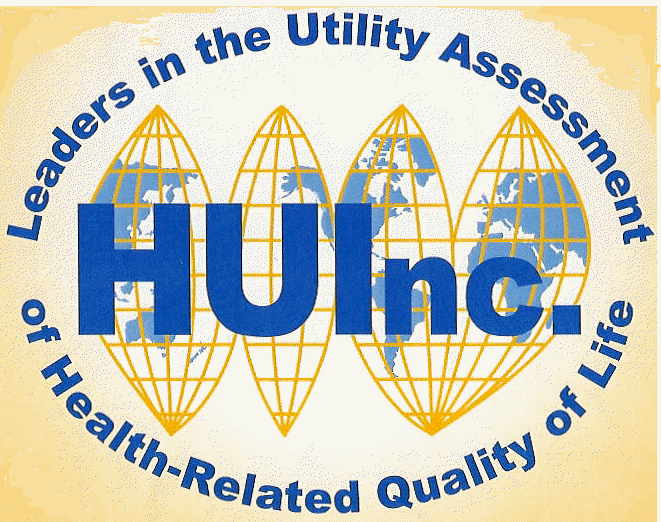
Multi-Attribute
Health Status Classification System:
Health
Utilities Index Mark 2 (HUI2)
 |
Multi-Attribute
Health Status Classification System:
|
| Attribute | Level | Description | |
| SENSATION | 1 | Able to see, hear, and speak normally for age. | |
| 2 | Requires equipment to see or hear or speak. | ||
| 3 | Sees, hears, or speaks with limitations even with equipment. | ||
| 4 | Blind, deaf, or mute. | ||
| MOBILITY | 1 | Able to walk, bend, lift, jump, and run normally for age. | |
| 2 | Walks, bends, lifts, jumps, or runs with some limitations but does not require help. | ||
| 3 | Requires mechanical equipment (such as canes, crutches, braces, or wheelchair) to walk or get around independently. | ||
| 4 | Requires the help of another person to walk or get around and requires mechanical equipment as well. | ||
| 5 | Unable to control or use arms and legs. | ||
| EMOTION | 1 | Generally happy and free from worry. | |
| 2 | Occasionally fretful, angry, irritable, anxious, depressed, or suffering "night terrors". | ||
| 3 | Often fretful, angry, irritable, anxious, depressed, or suffering "night terrors". | ||
| 4 | Almost always fretful, angry, irritable, anxious, depressed. | ||
| 5 | Extremely fretful, angry, irritable, anxious, or depressed usually requiring hospitalization or psychiatric institutional care. | ||
| COGNITIVE | 1 | Learns and remembers school work normally for age. | |
| 2 | Learns and remembers school work more slowly than classmates as judged by parents and/or teachers. | ||
| 3 | Learns and remembers very slowly and usually requires special educational assistance. | ||
| 4 | Unable to learn and remember. | ||
| SELF-CARE | 1 | Eats, bathes, dresses, and uses the toilet normally for age | |
| 2 | Eats, bathes, dresses, or uses the toilet independently with difficulty. | ||
| 3 | Requires mechanical equipment to eat, bathe, dress, or use the toilet independently. | ||
| 4 | Requires the help of another person to eat, bathe, dress, or use the toilet. | ||
| PAIN | 1 | Free of pain and discomfort. | |
| 2 | Occasional pain. Discomfort relieved by non-prescription drugs or self-control activity without disruption of normal activities. | ||
| 3 | Frequent pain. Discomfort relieved by oral medicines with occasional disruption of normal activities. | ||
| 4 | Frequent pain; frequent disruption of normal activities. Discomfort requires prescription narcotics for relief. | ||
| 5 | Severe pain. Pain not relieved by drugs and constantly disrupts normal activities. | ||
| FERTILITY | 1 | Able to have children with a fertile spouse. | |
| 2 | Difficulty in having children with a fertile spouse. | ||
| 3 | Unable to have children with a fertile spouse. | ||
For a pdf-formatted version of the HUI2 and HUI3 Classification Systems click here.
HUI2 Single-Attribute Utility Functions*
|
|
|
|
|
|
|
|
|
|
|
|
|
|
|
|
|
|
|
|
|
|
|
|
|
|
|
|
|
|
|
|
|
|
|
|
|
|
|
|
|
|
|
|
|
|
|
|
|
|
HUI2 Multi-Attribute Utility Function*
on Dead-Healthy Scale
|
x1 b1 |
x2 b2 |
x3 b3 |
x4 b4 |
x5 b5 |
x6 b6 |
x7 b7 |
|
|
|
|
|
|
|
|
|
|
|
|
|
|
|
|
|
|
|
|
|
|
|
|
|
|
|
|
|
|
|
|
|
|
|
|
Formula (Dead - Perfect Health scale) u* = 1.06 (b1 * b2 * b3 * b4 * b5 * b6 * b7) - 0.06
where u* is the utility of a chronic health state on a utility scale where dead has a utility of 0.00 and healthy has a utility of 1.00. Because the worst possible health state was judged by respondents as worse than death, it has a negative utility of -0.03. The standard error of u* is 0.015 for measurement error and sampling error, and 0.06 if model error is also included.Sources
Feeny, David H., George W. Torrance, and William J. Furlong, "Health Utilities Index," Chapter 26 In Bert Spilker, ed. Quality of Life and Pharmacoeconomics in Clinical Trials. Second Edition. Philadelphia: Lippincott-Raven Press, 1996, pp 239-252.
Torrance, George W., David H. Feeny, William J. Furlong, Ronald D. Barr, Yueming Zhang, and Qinan Wang, "Multi-Attribute Preference Functions for A Comprehensive Health Status Classification System: Health Utilities Index Mark 2." Medical Care, Vol. 34, No. 7, July 1996, pp 702-722.
 HUInc Leaders in the Utility Assessment of Health-Related Quality of Life
HUInc Leaders in the Utility Assessment of Health-Related Quality of Life